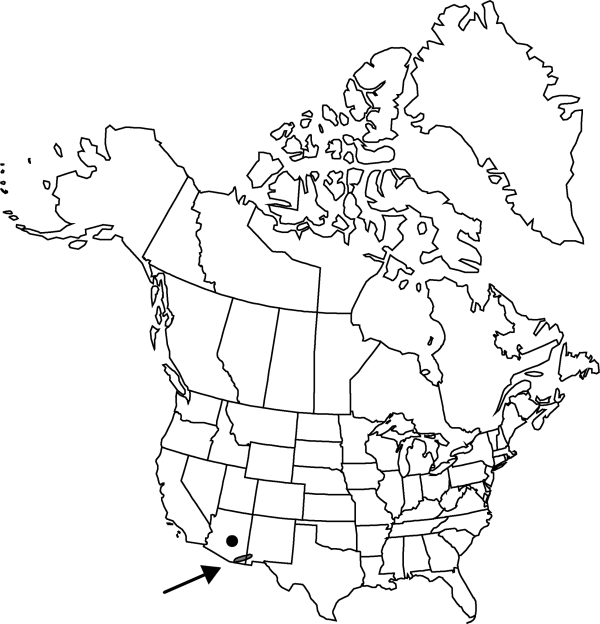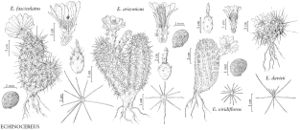Echinocereus arizonicus
Cactography 1926(1): 3. 1926.
Plants few-to-many branched. Stems usually erect, cylindric, 10–40 × 5–10 cm; ribs 8–13, slightly undulate; areoles 10–15 mm apart. Spines [8–] 9–18 per areole, straight or contorted; radial spines 7–14 per areole, appressed, yellowish to brownish, becoming gray, 5–25 mm; central spines 1–4 (c Arizona and Mexico) or 3–8 (elsewhere) per areole, spreading to projecting outward, brownish yellow to reddish black, becoming gray, terete (c Arizona) or angled to terete (elsewhere), 15–50 mm. Flowers 5.5–7 × 3.5–5 cm; flower tube 25–35 mm; flower tube spines 5–15 mm, hairs to 2 mm; inner tepals bright-orange-red to dark red distally, proximally paler (bases sometimes yellow or whitish), 25–40 × (5–) 10–15 mm, tips thick and rigid; anthers pink to brick-red or purple; nectar chamber 6–10 mm. Fruits green, brownish tinged, 20–30 mm, pulp white. 2n = 22.
Phenology: Flowering Apr–May; fruiting May–Jul.
Habitat: Chihuahuan Desert, desert scrub, interior chaparral, desert grasslands, steep walls of canyons, limestone hills, among granite boulders
Elevation: 1400-1900 m
Distribution

Ariz., N.Mex., Mexico (Chihuahua)
Discussion
Some populations of diploid claret-cup cacti in southeastern Arizona and southwestern New Mexico have recently been named Echinocereus arizonicus subsp. nigrihorridispinus W. Blum & Rutow, including numerous eastern populations previously misidentified as other taxa. Subspecies arizonicus, of conservation concern, remains known only from central Arizona. Infraspecific taxa within E. arizonicus are not treated formally here because their taxonomic boundaries remain controversial.
Echinocereus arizonicus superficially resembles the dioecious tetraploid E. coccineus var. rosei of the Chihuahuan Desert, and several of its populations were mapped by L. D. Benson (1969, 1982) as part of E. triglochidatus var. neomexicanus (Standley) Standley ex W. T. Marshall. Echinocereus arizonicus subsp. nigrihorridispinus superficially resembles the partially sympatric, synoecious tetraploid recently named E. santaritensis W. Blum & Rutow (a hermaphroditic geographic race of E. coccineus), which has much longer hairs on the flowers, a narrower flower tube, and relatively slender spines. Irrespective of the misleading vegetative similarities between diploid E. arizonicus and its polyploid relatives, E. arizonicus differs strongly from both varieties of the diploid E. triglochidiatus.
Selected References
None.
Lower Taxa
"thick" is not a number.
